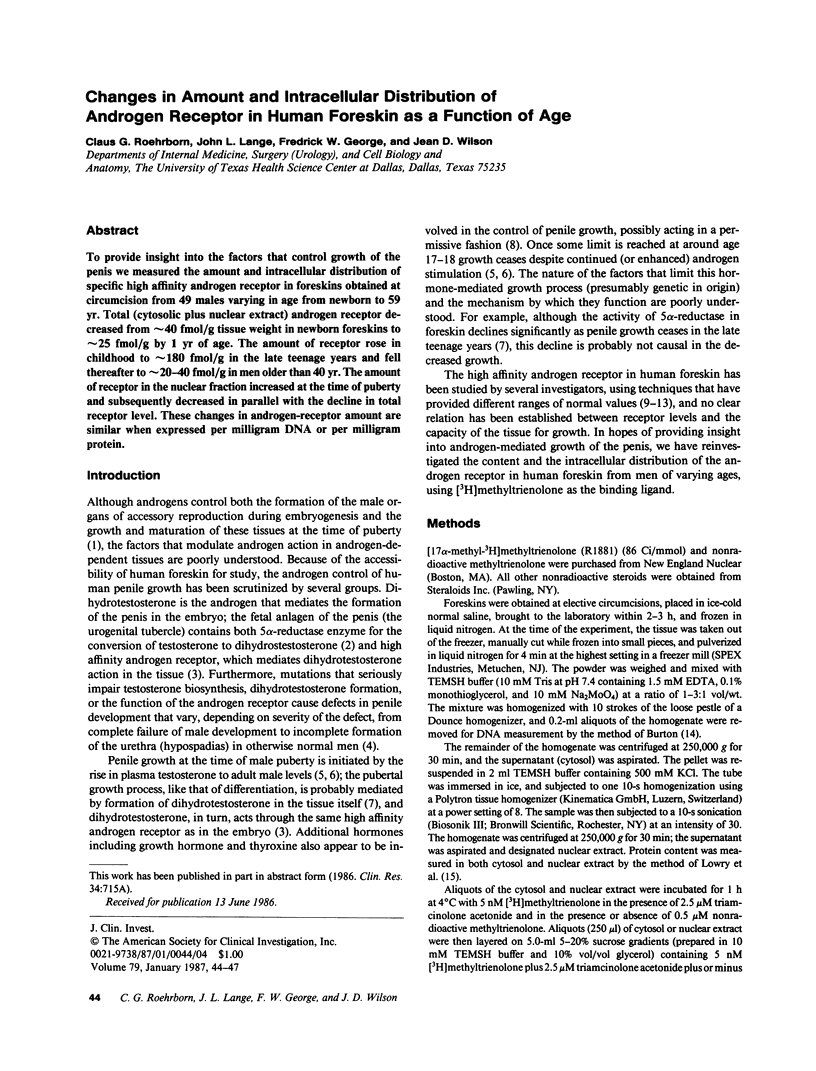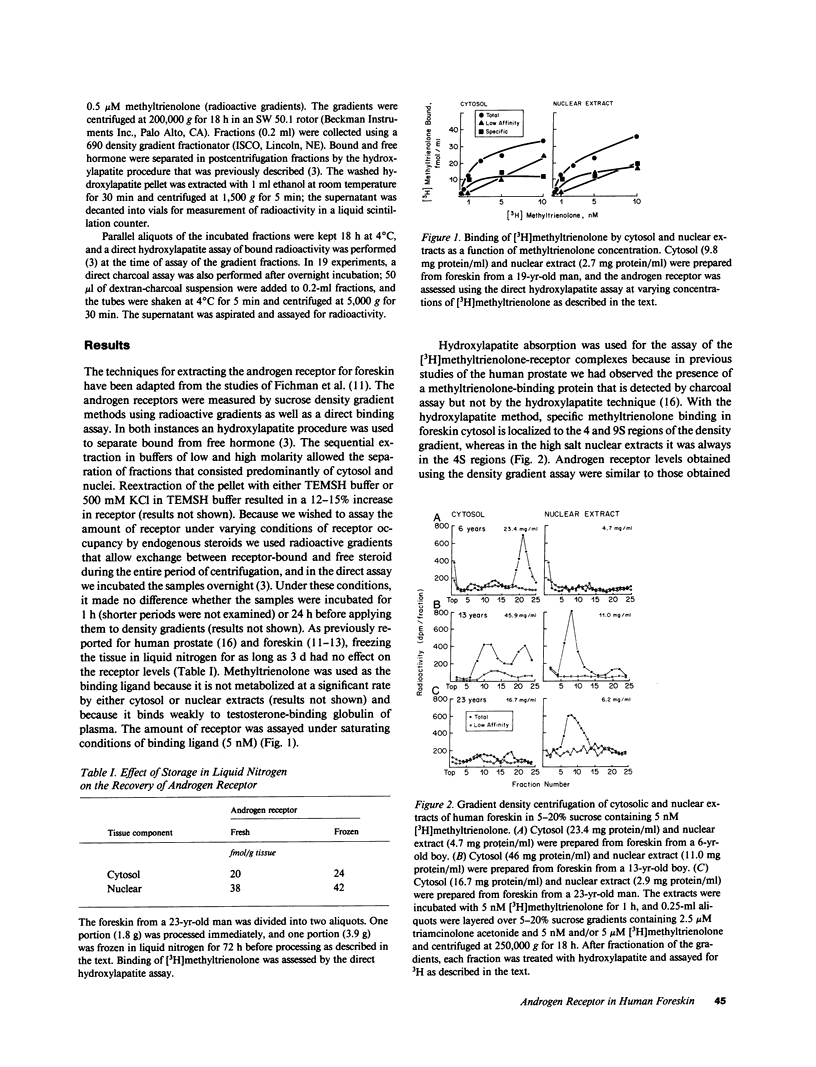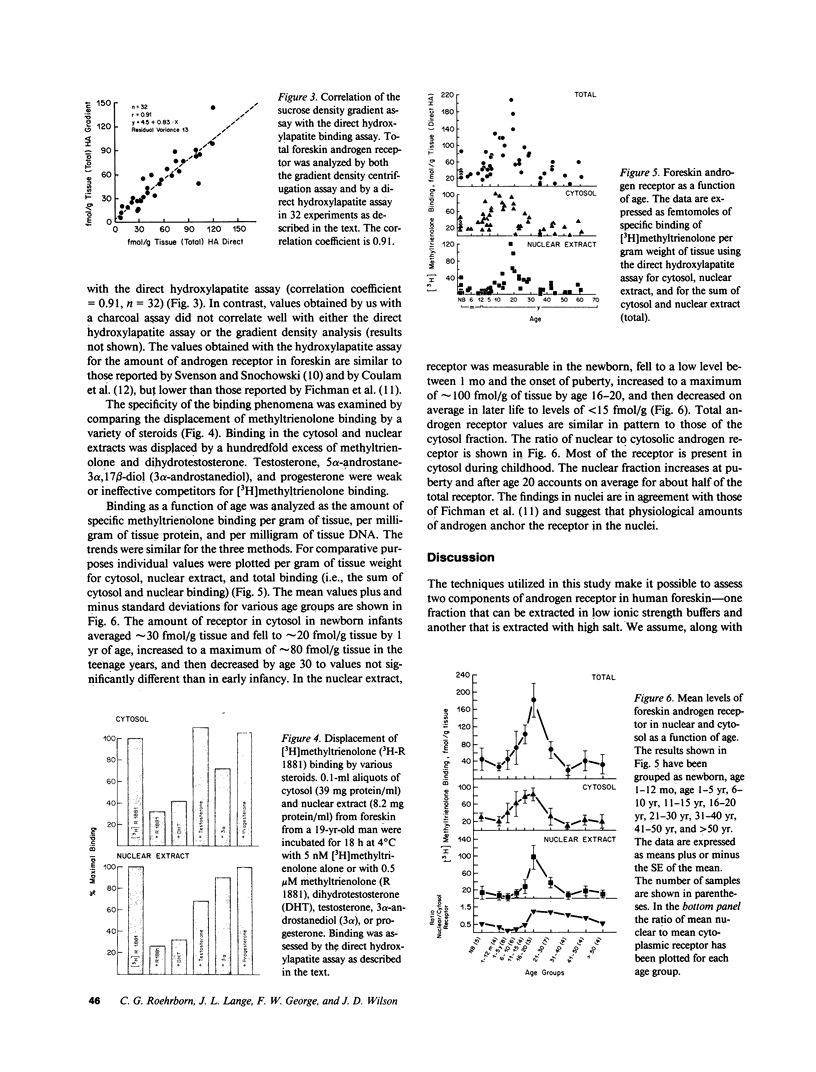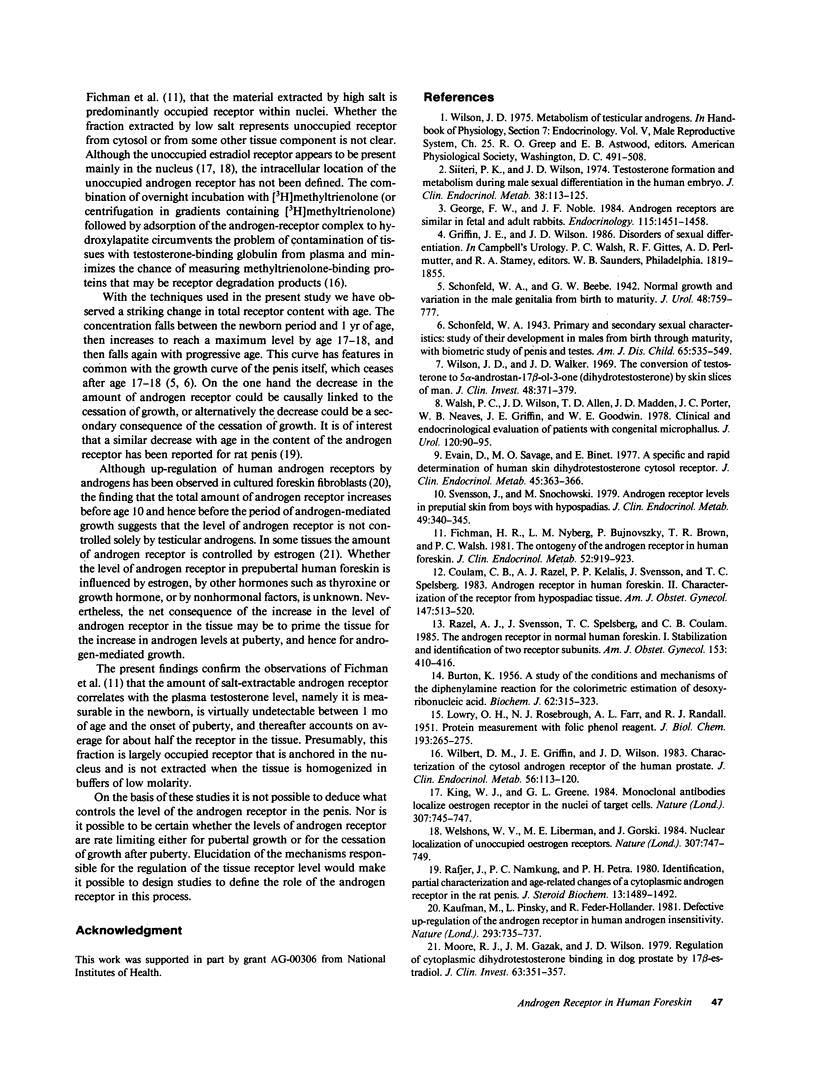Abstract
To provide insight into the factors that control growth of the penis we measured the amount and intracellular distribution of specific high affinity androgen receptor in foreskins obtained at circumcision from 49 males varying in age from newborn to 59 yr. Total (cytosolic plus nuclear extract) androgen receptor decreased from approximately 40 fmol/g tissue weight in newborn foreskins to approximately 25 fmol/g by 1 yr of age. The amount of receptor rose in childhood to approximately 180 fmol/g in the late teenage years and fell thereafter to approximately 20-40 fmol/g in men older than 40 yr. The amount of receptor in the nuclear fraction increased at the time of puberty and subsequently decreased in parallel with the decline in total receptor level. These changes in androgen-receptor amount are similar when expressed per milligram DNA or per milligram protein.
Full text
PDF



Images in this article
Selected References
These references are in PubMed. This may not be the complete list of references from this article.
- BURTON K. A study of the conditions and mechanism of the diphenylamine reaction for the colorimetric estimation of deoxyribonucleic acid. Biochem J. 1956 Feb;62(2):315–323. doi: 10.1042/bj0620315. [DOI] [PMC free article] [PubMed] [Google Scholar]
- Coulam C. B., Razel A. J., Kelalis P. P., Svensson J., Spelsberg T. C. Androgen receptor in human foreskin. II. Characterization of the receptor from hypospadiac tissue. Am J Obstet Gynecol. 1983 Nov 1;147(5):513–520. doi: 10.1016/0002-9378(83)90008-x. [DOI] [PubMed] [Google Scholar]
- Evain D., Savage N. O., Binet E. A specific and rapid determination of human skin dihydrotestosterone cytosol receptor. J Clin Endocrinol Metab. 1977 Aug;45(2):363–366. doi: 10.1210/jcem-45-2-363. [DOI] [PubMed] [Google Scholar]
- Fichman K. R., Nyberg L. M., Bujnovszky P., Brown T. R., Walsh P. C. The ontogeny of the androgen receptor in human foreskin. J Clin Endocrinol Metab. 1981 May;52(5):919–923. doi: 10.1210/jcem-52-5-919. [DOI] [PubMed] [Google Scholar]
- George F. W., Noble J. F. Androgen receptors are similar in fetal and adult rabbits. Endocrinology. 1984 Oct;115(4):1451–1458. doi: 10.1210/endo-115-4-1451. [DOI] [PubMed] [Google Scholar]
- Kaufman M., Pinsky L., Feder-Hollander R. Defective up-regulation of the androgen receptor in human androgen insensitivity. Nature. 1981 Oct 29;293(5835):735–737. doi: 10.1038/293735a0. [DOI] [PubMed] [Google Scholar]
- King W. J., Greene G. L. Monoclonal antibodies localize oestrogen receptor in the nuclei of target cells. Nature. 1984 Feb 23;307(5953):745–747. doi: 10.1038/307745a0. [DOI] [PubMed] [Google Scholar]
- LOWRY O. H., ROSEBROUGH N. J., FARR A. L., RANDALL R. J. Protein measurement with the Folin phenol reagent. J Biol Chem. 1951 Nov;193(1):265–275. [PubMed] [Google Scholar]
- Moore R. J., Gazak J. M., Wilson J. D. Regulation of cytoplasmic dihydrotestosterone binding in dog prostate by 17 beta-estradiol. J Clin Invest. 1979 Mar;63(3):351–357. doi: 10.1172/JCI109310. [DOI] [PMC free article] [PubMed] [Google Scholar]
- Rajfer J., Namkung P. C., Petra P. H. Identification, partial characterization and age-related changes of a cytoplasmic androgen receptor in the rat penis. J Steroid Biochem. 1980 Dec;13(12):1489–1492. doi: 10.1016/0022-4731(80)90064-3. [DOI] [PubMed] [Google Scholar]
- Razel A. J., Svensson J., Spelsberg T. C., Coulam C. B. The androgen receptor in normal human foreskin. I. Stabilization and identification of two receptor subunits. Am J Obstet Gynecol. 1985 Oct 15;153(4):410–416. doi: 10.1016/0002-9378(85)90079-1. [DOI] [PubMed] [Google Scholar]
- Siiteri P. K., Wilson J. D. Testosterone formation and metabolism during male sexual differentiation in the human embryo. J Clin Endocrinol Metab. 1974 Jan;38(1):113–125. doi: 10.1210/jcem-38-1-113. [DOI] [PubMed] [Google Scholar]
- Svensson J., Snochowski M. Androgen receptor levels in preputial skin from boys with hypospadias. J Clin Endocrinol Metab. 1979 Sep;49(3):340–345. doi: 10.1210/jcem-49-3-340. [DOI] [PubMed] [Google Scholar]
- Walsh P. C., Wilson J. D., Allen T. D., Madden J. D., Porter J. C., Neaves W. B., Griffin J. E., Goodwin W. E. Clinical and endocrinological evaluation of patients with congenital microphallus. J Urol. 1978 Jul;120(1):90–95. doi: 10.1016/s0022-5347(17)57057-3. [DOI] [PubMed] [Google Scholar]
- Welshons W. V., Lieberman M. E., Gorski J. Nuclear localization of unoccupied oestrogen receptors. Nature. 1984 Feb 23;307(5953):747–749. doi: 10.1038/307747a0. [DOI] [PubMed] [Google Scholar]
- Wilbert D. M., Griffin J. E., Wilson J. D. Characterization of the cytosol androgen receptor of the human prostate. J Clin Endocrinol Metab. 1983 Jan;56(1):113–120. doi: 10.1210/jcem-56-1-113. [DOI] [PubMed] [Google Scholar]
- Wilson J. D., Walker J. D. The conversion of testosterone to 5 alpha-androstan-17 beta-ol-3-one (dihydrotestosterone) by skin slices of man. J Clin Invest. 1969 Feb;48(2):371–379. doi: 10.1172/JCI105994. [DOI] [PMC free article] [PubMed] [Google Scholar]




